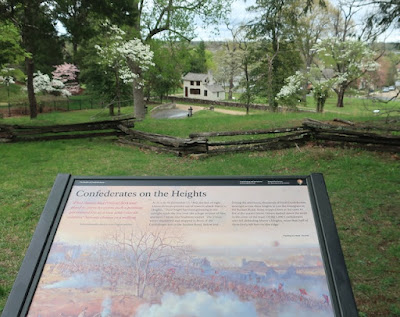On our way south for Spring Break, we stopped in Fredericksburg, Virginia, to visit one of the battlefields. Right by the
Fredericksburg Battlefield Visitor Center is the Sunken Road, the site of one of the bloodiest and most futile engagements of the war.
 |
| By the sign |
 |
| The actual visitor center |
The center has several exhibits describing the battles around the town, though the main focus is on the
Battle of Fredericksburg, where the Union army charged across the Rappahannock River into the town. The devastation was enormous, with many buildings destroyed and nearly 13,000 casualties on the Union side. The Confederate army had only 5000 casualties. Nine generals were wounded or killed during the conflict which raged from December 11 to 15, 1862.
 |
| Diorama of damage based on a photo |
The uniforms in the early part of the war were less uniform--many units had their own. Below are some examples.
 |
| From a Pennsylvania unit |
 |
| Confederate chaplain's coat |
 |
| A drum used on the battlefield |
 |
| Weapons |
Outside the center, the trail starts at the back of the parking lot with a view up to the cemetery lodge. A large national cemetery was made on Marye's Heights overlooking the Sunken Road and the town.
 |
| Cemetery lodge |
The road actually is lower than the surrounding terrain, with the hill of Marye's Heights on one side and a retaining wall on the other. The wall near the visitor's center is a reconstruction from the 1930s (there's also a reconstruction from 2004 and some of the original wall).
 |
| Not the actual wall, but what it looked like |
 |
| The ridge of Marye's Heights (looks taller in person) |
The Stephens House is no longer present along the road. It was not destroyed in the battle but removed after the war. The foundation was discovered later by archeologists.
 |
| Stephens house area |
The Innis House is a survivor of the battle though it was so riddled with bullets that Confederate General McLaws quipped that the house "had no space as large as two hands on it that had not been pierced."
 |
| Innis House |
A moving memorial is dedicated to Richard Rowland Kirkland, a Confederate soldier. During a lull in the fighting, the land between the Sunken Road and the Union line was littered with the dead and dying. The sounds of their agony inspired him to crawl out with canteens of water to provide some relief to the wounded. He gave water to all the soldiers, Confederate and Union. No soldiers ever fired on him.
 |
| Kirkland memorial |
 |
| Back of the memorial |
Also on the Heights is Brompton, a home that is now the private residence of the president of the
University of Mary Washington. The university is named after George Washington's mom, who lived in Fredericksburg for a long time.
 |
| Brompton |
By the Kirkland Monument some of original wall is extant, with a sign describing it.
 |
| Original wall |
The trail goes up onto the Heights with a view of the town. The Confederates put their artillery up here, a relatively safe spot in the battle that let them easily fire on the Union troops.
 |
| Looking into town |
 |
| Parking lot and visitor center |
 |
| Some guns |
The National Cemetery has mostly soldiers who died in the area, along with some wives. No more burials are happening since it is now full!
 |
| Entrance to the cemetery |
 |
| Small grave markers |
 |
| A well-funded marker |
 |
| A New Jersey soldier! |
Humphreys Monument commemorates the last charge of the Union on December 13. Humphreys' division was entirely Pennsylvania recruits and lost a quarter of its men in the assault. The State of Pennsylvania funded the monument.
 |
| Humphreys Monument |
The Fifth Corps Monument was erected in 1901 by General Butterfield, the Union commander at the battle.
 |
| Fifth Corps monument |
 |
| List of various units in the Fifth--see details here |
The history of the battle is sobering and marks how the war was a long, frustrating conflict that cost the country a lot.


























No comments:
Post a Comment